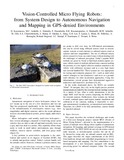Vision-Controlled Micro Flying Robots: From System Design to Autonomous Navigation and Mapping in GPS-Denied Environments
| dc.contributor.author | Scaramuzza, Davide | |
| dc.contributor.author | Achtelik, Michael | |
| dc.contributor.author | Doitsidis, Lefteris | |
| dc.contributor.author | Fraundorfer, Friedrich | |
| dc.contributor.author | Kosmatopoulos, Elias | |
| dc.contributor.author | Martinelli, Agostino | |
| dc.contributor.author | Achtelik, Markus Wilhelm | |
| dc.contributor.author | Chli, Margarita | |
| dc.contributor.author | Chatzichristofis, Savvas A. | |
| dc.contributor.author | Kneip, Laurent | |
| dc.contributor.author | Gurdan, Daniel | |
| dc.contributor.author | Heng, Lionel | |
| dc.contributor.author | Lee, Gim Hee | |
| dc.contributor.author | Lynen, Simon | |
| dc.contributor.author | Meier, Lorenz | |
| dc.contributor.author | Pollefeys, Marc | |
| dc.contributor.author | Renzaglia, Alessandro | |
| dc.contributor.author | Siegwart, Roland | |
| dc.contributor.author | Stumpf, Jan Carsten | |
| dc.contributor.author | Tanskanen, Petri | |
| dc.contributor.author | Troiani, Chiara | |
| dc.contributor.author | Weiss, Stephan | |
| dc.date.accessioned | 2017-10-24T10:43:45Z | |
| dc.date.available | 2017-10-24T10:43:45Z | |
| dc.date.issued | 2014 | |
| dc.identifier.issn | 1070-9932 | |
| dc.identifier.uri | http://hdl.handle.net/11728/10147 | |
| dc.description.abstract | Autonomous micro helicopters are about to play a major role in tasks like search and rescue, environment monitoring, security surveillance, inspection, etc. If they are further realized in small scale, they can also be used in narrow outdoor and indoor environments and represent only a limited risk for people. However, for such operations, navigating based on GPS information only is not sufficient. Fully autonomous operation in cities or other dense environments requires micro helicopters to fly at low altitudes---where GPS signals are often shadowed---or indoors, and to actively explore unknown environments while avoiding collisions and creating maps. This involves a number of challenges on all levels of helicopter design, perception, actuation, control, and navigation, which still have to be solved. The SFLY project was an EU-funded project with the goal to create a swarm of vision-controlled micro aerial vehicles (MAVs) capable of autonomous navigation, 3D mapping, and optimal surveillance coverage in GPS-denied environments. The SFLY MAVs do not rely on remote control, radio beacons, or motion-capture systems but can fly all by themselves using only a single onboard camera and an IMU. This paper describes the technical challenges that have been faced and the results achieved, from hardware design and embedded programming to vision-based navigation and mapping, with an overview of how all the modules work and how they have been integrated into the final system. Code, datasets, and videos are publicly available to the Robotics community. Experimental results demonstrating three MAVs navigating autonomously in an unknown GPS-denied environment and performing 3D mapping and optimal surveillance coverage are presented. | en_UK |
| dc.language.iso | en | en_UK |
| dc.publisher | IEEE | en_UK |
| dc.relation.ispartofseries | IEEE Robotics and Automation Magazine;Volume: 21, Issue: 3 | |
| dc.rights.uri | http://creativecommons.org/licenses/by-nc-nd/4.0/ | en_UK |
| dc.subject | Robot navigation | en_UK |
| dc.subject | Helicopters | en_UK |
| dc.subject | Mobile robots | en_UK |
| dc.subject | Payloads | en_UK |
| dc.subject | Batteries | en_UK |
| dc.subject | Surveillance | en_UK |
| dc.subject | Intelligent vehicles | en_UK |
| dc.subject | Aircraft navigation | en_UK |
| dc.subject | Global Positioning System | en_UK |
| dc.title | Vision-Controlled Micro Flying Robots: From System Design to Autonomous Navigation and Mapping in GPS-Denied Environments | en_UK |
| dc.type | Article | en_UK |
| dc.doi | 10.1109/MRA.2014.2322295 | en_UK |
Files in this item
This item appears in the following Collection(s)
-
Articles69
Άρθρα


